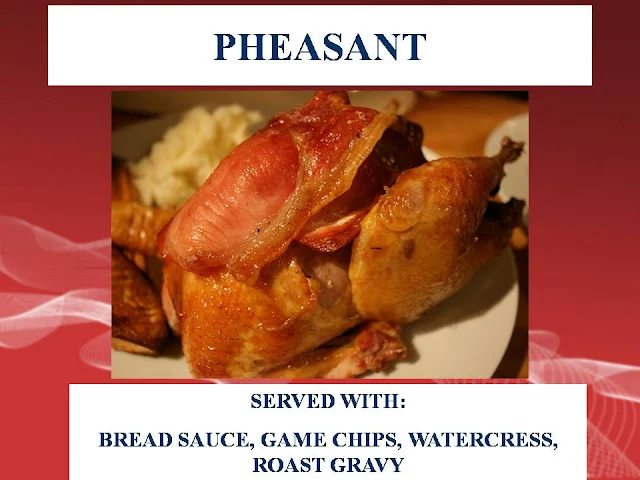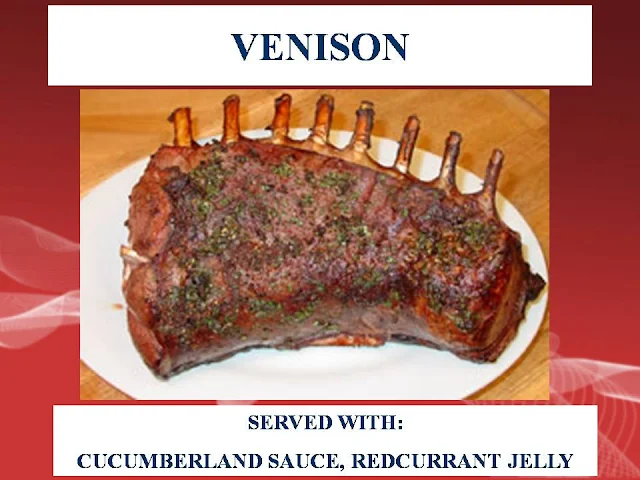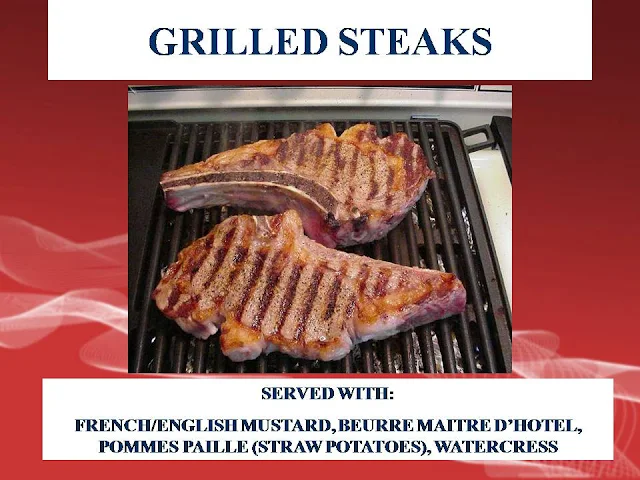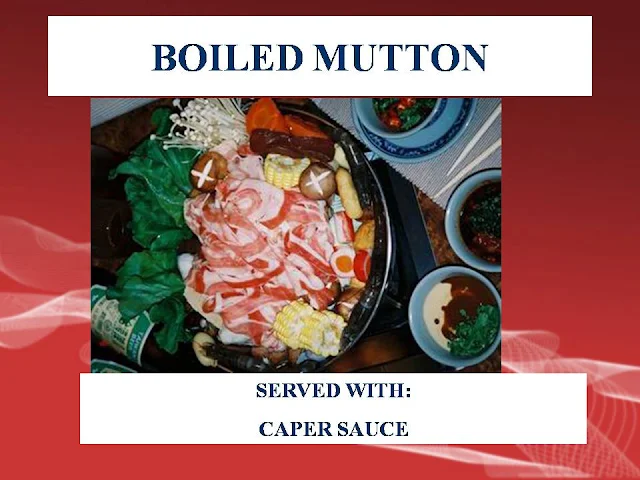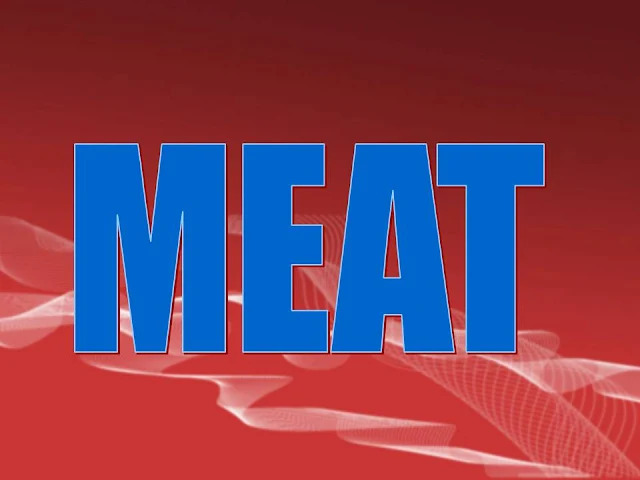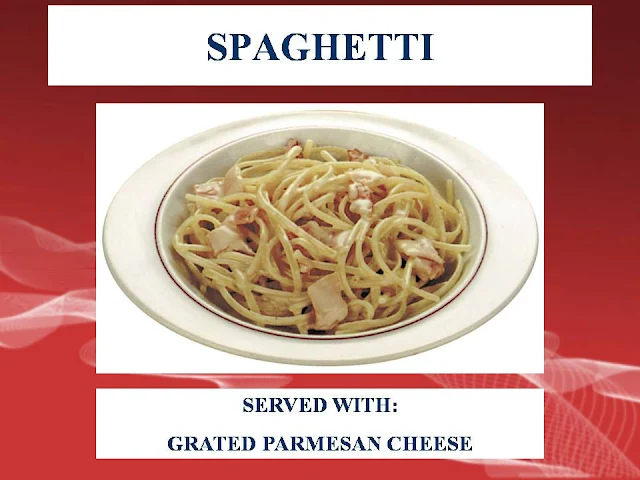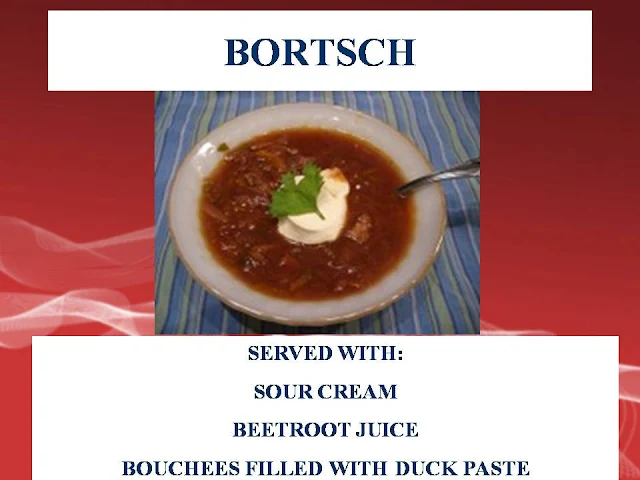A platform for the connoisseurs to indulge with the mesmerizing beverages and lip smacking global cuisines, access the information and review and interact at the same time. This is also a huge support tool for the Hospitality aspirants pursuing any Hotel Management Program or is a beginner with the Hospitality Industry.
Amazon
Thursday, August 5, 2010
SERVICE TECHNIQUES
Serving of Food with One Hand
This service technique is used only for platter service and
involves the so-called long grip. In the long grip, the utensils are held
in the right hand. Hold the spoon between the index and middle
fingers and the fork between the index finger and the thumb. The
curves of the spoon and fork should align. Gently slide the spoon
under the item to be served, so that it is held between the fork and
spoon. Remove your index finger, apply light pressure to the fork,
and lift.
Serving of Food with Both Hands
This technique is used when working at a side table or a
buffet. When serving with both hands, hold the spoon in your right
hand and the fork in your left hand. If the food is prepared in a
sauce, always scrape the bottom of the spoon with the fork, to
prevent drips and to keep the plate you are preparing clean and
neat.
Arranging Food on the Plates
To the uninitiated, it might seem very simple to arrange food
nicely on a plate. Actually, in a refined service, food is arranged
according to particular rules that are followed the world over. Meat is
always placed at the lower part of the plate. Sauces are served
separately in a sauce boat, or they are served to the left of the meat
or fish. When a dish is cooked in a sauce, such as a curry or stews,
the sauce is served over the meat. Compound, or flavored, butters,
such as d’hote or d'hotel butter or herb butter, are placed directly on
the meat. Side dishes are arranged to achieve color harmony. A
piece of cake or pie should be served with the point facing toward
the guest. Plates with a logo or other graphic decoration should be
arranged so that the decoration is placed in front of the guest. Plates
should never appear overloaded; the rims must always be free of
food and without drip smears. Hot food is always served on hot
plates; cold food, on cold plates.
Pouring Beverages
Hold glasses by the foot or stem only, to avoid fingerprints.
Glasses are always placed to the right of the guest with the right
hand. If the glass has a logo, it should face the guest. Beverages are
always poured from the right side of the guest. When serving heavy
red wines that have been decanted or are in a wine basket, hold the
glass, slightly slanted, on the table with left hand and slowly pour out
the wine with the right hand, so that the wine sediment is not
disturbed. A bottle of wine is first presented to the host. Then the
bottle is opened, and a small amount is poured out for the host. After
the host approves, the guests are served first and the host's glass
last.
Sequence of Clearing
When an aperitif has been served, the empty glasses are
cleared only after the wine is served. If a white wine is served with
the appetizer, the empty glasses are removed only after the red wine
has been poured. The red-wine glasses are cleared after the coffee
or after-dinner drinks are served. When guests are smoking, ash
trays are always changed before a new course is served. After the
guests have finished the main course, any platters or serving dishes
on the table are removed first. Then the dinner plates are cleared
along with the flatware. Finally, any smaller plates, bread plates, and
finger bowls are removed. Before dessert is served, the table is
totally cleared, except for flowers or other decorations.
This service technique is used only for platter service and
involves the so-called long grip. In the long grip, the utensils are held
in the right hand. Hold the spoon between the index and middle
fingers and the fork between the index finger and the thumb. The
curves of the spoon and fork should align. Gently slide the spoon
under the item to be served, so that it is held between the fork and
spoon. Remove your index finger, apply light pressure to the fork,
and lift.
Serving of Food with Both Hands
This technique is used when working at a side table or a
buffet. When serving with both hands, hold the spoon in your right
hand and the fork in your left hand. If the food is prepared in a
sauce, always scrape the bottom of the spoon with the fork, to
prevent drips and to keep the plate you are preparing clean and
neat.
Arranging Food on the Plates
To the uninitiated, it might seem very simple to arrange food
nicely on a plate. Actually, in a refined service, food is arranged
according to particular rules that are followed the world over. Meat is
always placed at the lower part of the plate. Sauces are served
separately in a sauce boat, or they are served to the left of the meat
or fish. When a dish is cooked in a sauce, such as a curry or stews,
the sauce is served over the meat. Compound, or flavored, butters,
such as d’hote or d'hotel butter or herb butter, are placed directly on
the meat. Side dishes are arranged to achieve color harmony. A
piece of cake or pie should be served with the point facing toward
the guest. Plates with a logo or other graphic decoration should be
arranged so that the decoration is placed in front of the guest. Plates
should never appear overloaded; the rims must always be free of
food and without drip smears. Hot food is always served on hot
plates; cold food, on cold plates.
Pouring Beverages
Hold glasses by the foot or stem only, to avoid fingerprints.
Glasses are always placed to the right of the guest with the right
hand. If the glass has a logo, it should face the guest. Beverages are
always poured from the right side of the guest. When serving heavy
red wines that have been decanted or are in a wine basket, hold the
glass, slightly slanted, on the table with left hand and slowly pour out
the wine with the right hand, so that the wine sediment is not
disturbed. A bottle of wine is first presented to the host. Then the
bottle is opened, and a small amount is poured out for the host. After
the host approves, the guests are served first and the host's glass
last.
Sequence of Clearing
When an aperitif has been served, the empty glasses are
cleared only after the wine is served. If a white wine is served with
the appetizer, the empty glasses are removed only after the red wine
has been poured. The red-wine glasses are cleared after the coffee
or after-dinner drinks are served. When guests are smoking, ash
trays are always changed before a new course is served. After the
guests have finished the main course, any platters or serving dishes
on the table are removed first. Then the dinner plates are cleared
along with the flatware. Finally, any smaller plates, bread plates, and
finger bowls are removed. Before dessert is served, the table is
totally cleared, except for flowers or other decorations.
BUFFET SERVICE
This is also called self service and is normally used in
banquet functions and i n some restaurants. Food is attractively
arranged on a long table, classified and arranged according to
proper sequence, from appetizers to desserts. Soup is placed on a
soup tureen and the hot entrees in chaffing dishes to keep them
warm. Some equipment like dinner plates and saucers are laid
down right on the buffet table. Instead of the waiter serving the
guests, the guests go to the buffet table pick up plates, china,
cuttkery and knapkin and all other items and serve themselves of
their own choice.
Advantages:
1. It is a fast service.
2. It requires less staff to render the service needed.
3. The presentation of the different dishes can be appetizing.
Disadvantages:
1. It may result in shortage of food especially when the early
ones may serve themselves more; thus very little food is left
for the latecomers.
banquet functions and i n some restaurants. Food is attractively
arranged on a long table, classified and arranged according to
proper sequence, from appetizers to desserts. Soup is placed on a
soup tureen and the hot entrees in chaffing dishes to keep them
warm. Some equipment like dinner plates and saucers are laid
down right on the buffet table. Instead of the waiter serving the
guests, the guests go to the buffet table pick up plates, china,
cuttkery and knapkin and all other items and serve themselves of
their own choice.
Advantages:
1. It is a fast service.
2. It requires less staff to render the service needed.
3. The presentation of the different dishes can be appetizing.
Disadvantages:
1. It may result in shortage of food especially when the early
ones may serve themselves more; thus very little food is left
for the latecomers.
RUSSIAN SERVICE
This type of service is the same as that of French service.
However, in Russian service, the food is fully prepared and pre-cut in
the kitchen and then neatly arranged on silver platters by the Chef.
The waiter then shows the platter to the guest as a polite gesture
and serves the food to the individual plates of the guests using
serving cutleries.
Advantages:
1. Only one waiter is needed to each station.
2. Elegant and entertaining.
3. No extra space is needed for the equipment (except for the
side stand).
4. It guarantees equal portions because the food is pre-cut and
already served.
5. Gives the guests personal attention.
Disadvantages:
1. It requires a big initial investment in silver equipment.
2. If many guests are served from one platter, the last one to be
served may see a rather less attractive display.
3. If every guest in a party orders a different dish like steak or
fish, the waiter must carry very heavily loaded tray / trays to
the dining room.
However, in Russian service, the food is fully prepared and pre-cut in
the kitchen and then neatly arranged on silver platters by the Chef.
The waiter then shows the platter to the guest as a polite gesture
and serves the food to the individual plates of the guests using
serving cutleries.
Advantages:
1. Only one waiter is needed to each station.
2. Elegant and entertaining.
3. No extra space is needed for the equipment (except for the
side stand).
4. It guarantees equal portions because the food is pre-cut and
already served.
5. Gives the guests personal attention.
Disadvantages:
1. It requires a big initial investment in silver equipment.
2. If many guests are served from one platter, the last one to be
served may see a rather less attractive display.
3. If every guest in a party orders a different dish like steak or
fish, the waiter must carry very heavily loaded tray / trays to
the dining room.
ENGLISH SERVICE
This type of service is also known as "family style" service. In
this service, the soup tureen is placed before the host alongside with
preheated soup plates and hands them to the waiter, indicating the
person to be served. The same procedure is followed with the main
entree. If so desired, the partly filled dinner plate is presented to the
hostess who serves the vegetables from large serving dishes placed
before her. Then the waiter places the plate before the guests. This
type of service is usually found in coffee shops, family restaurants,
counter service, etc.
Advantages:
1. It is fast. Plates of food are served immediately at the proper
temperature.
2. It is inexpensive.
3. It requires no special equipment.
Disadvantages:
1. Less showmanship.
2. Reduced personalized attention to the customer.
this service, the soup tureen is placed before the host alongside with
preheated soup plates and hands them to the waiter, indicating the
person to be served. The same procedure is followed with the main
entree. If so desired, the partly filled dinner plate is presented to the
hostess who serves the vegetables from large serving dishes placed
before her. Then the waiter places the plate before the guests. This
type of service is usually found in coffee shops, family restaurants,
counter service, etc.
Advantages:
1. It is fast. Plates of food are served immediately at the proper
temperature.
2. It is inexpensive.
3. It requires no special equipment.
Disadvantages:
1. Less showmanship.
2. Reduced personalized attention to the customer.
AMERICAN SERVICE
This is usually called "plate service” because the food is
already placed in the plate in the kitchen ready to be served to the
guests. This type of service is used in coffee shops where there is a
demand for quick and simple service. It requires minimal training for
novice waiters and waitresses.
Advantages:
1. It is a fast and simple service.
2. It is inexpensive. One waiter or waitress can serve many
guests and no special service equipment is necessary.
3. It does not require highly trained technical staff that demands
for higher pay.
Disadvantages:
1. Less showmanship
2. Reduced personalized attention
already placed in the plate in the kitchen ready to be served to the
guests. This type of service is used in coffee shops where there is a
demand for quick and simple service. It requires minimal training for
novice waiters and waitresses.
Advantages:
1. It is a fast and simple service.
2. It is inexpensive. One waiter or waitress can serve many
guests and no special service equipment is necessary.
3. It does not require highly trained technical staff that demands
for higher pay.
Disadvantages:
1. Less showmanship
2. Reduced personalized attention
FRENCH SERVICE
French service differs from others in that all food is served
from the gueridon. This is a rolling cart the same height as the
guest's table. The gueridon is covered with a cloth and is placed
side-by-side with the table. It is equipped with a small alcohol stove,
or rechaud, that is used to keep the food warm for the preparation of
sauces, crepes suzette, jubilee and other special dishes. This
service is very elaborate and elegant. The food is partially prepared
in the kitchen and completed by the Chef or Headwaiter in full view
of the customer. Service of this type requires not only technical
expertise on food preparation but also a good showmanship. The
Chef carries out certain activities like carving meats, preparing
flambe, etc. with flair and showmanship.
Advantages:
1. The guest s given personalized attention making him feel
important.
2. It makes the guest feel that he is receiving a royal treatment.
3. Th service is elegant and entertaining.
4. It commands higher price than other forms of service (pay for
the service).
Disadvantages:
1. It is a slow service.
2. It is expensive because it requires large professional staff.
3. It requires a bigger dining room space to make service and
food preparation convenient.
from the gueridon. This is a rolling cart the same height as the
guest's table. The gueridon is covered with a cloth and is placed
side-by-side with the table. It is equipped with a small alcohol stove,
or rechaud, that is used to keep the food warm for the preparation of
sauces, crepes suzette, jubilee and other special dishes. This
service is very elaborate and elegant. The food is partially prepared
in the kitchen and completed by the Chef or Headwaiter in full view
of the customer. Service of this type requires not only technical
expertise on food preparation but also a good showmanship. The
Chef carries out certain activities like carving meats, preparing
flambe, etc. with flair and showmanship.
Advantages:
1. The guest s given personalized attention making him feel
important.
2. It makes the guest feel that he is receiving a royal treatment.
3. Th service is elegant and entertaining.
4. It commands higher price than other forms of service (pay for
the service).
Disadvantages:
1. It is a slow service.
2. It is expensive because it requires large professional staff.
3. It requires a bigger dining room space to make service and
food preparation convenient.
STYLES OF SERVICE
Five styles of services are internationally recognized:
1. French service or gueridon service
2. American service or plate service
3. English service
4. Russian service
5. Buffet service
1. French service or gueridon service
2. American service or plate service
3. English service
4. Russian service
5. Buffet service
FOOD SERVICE
Service is a term that is used to describe the manner and
method in which food is served to guests in foodservice operations.
In former times, this often constituted an elaborate and convulated
protocol, much of which is no longer in vogue, notwithstanding that
some technical terms are still in use today.
When food is placed directly on plates and served to guests
at the table, this is referred to as service a lassiette. When guests
serve themselves from the dish on the table with serving spoons, this
is referred to a service a la francaise. When the waiter places the
food on the diner’s plate this is referred to as service in the a la
anglaise s t yle. In service a la russe, which is also known as au
gueridon, the dish is first offered to guest for viewing or approval,
and then food is served onto the diner’s plate at a pedestal table or
gueridon, which is located close to or besides the dinning table.
method in which food is served to guests in foodservice operations.
In former times, this often constituted an elaborate and convulated
protocol, much of which is no longer in vogue, notwithstanding that
some technical terms are still in use today.
When food is placed directly on plates and served to guests
at the table, this is referred to as service a lassiette. When guests
serve themselves from the dish on the table with serving spoons, this
is referred to a service a la francaise. When the waiter places the
food on the diner’s plate this is referred to as service in the a la
anglaise s t yle. In service a la russe, which is also known as au
gueridon, the dish is first offered to guest for viewing or approval,
and then food is served onto the diner’s plate at a pedestal table or
gueridon, which is located close to or besides the dinning table.
Tuesday, August 3, 2010
Subscribe to:
Comments (Atom)
Is consuming Wine daily good for health?
The idea of consuming wine daily, particularly red wine, has been a topic of interest for many years, with some studies suggesting potentia...
-
Pot stills and patent stills are two different types of distillation apparatus used in the production of alcoholic beverages, particularly...
-
The quality of service staff in any establishment reflects the quality of the establishment itself. No matter how good the food and ambien...
-
1) The table on which a tablecloth is to be spread, should be first covered with a baize base cloth, for the following reasons: a. To pro...
